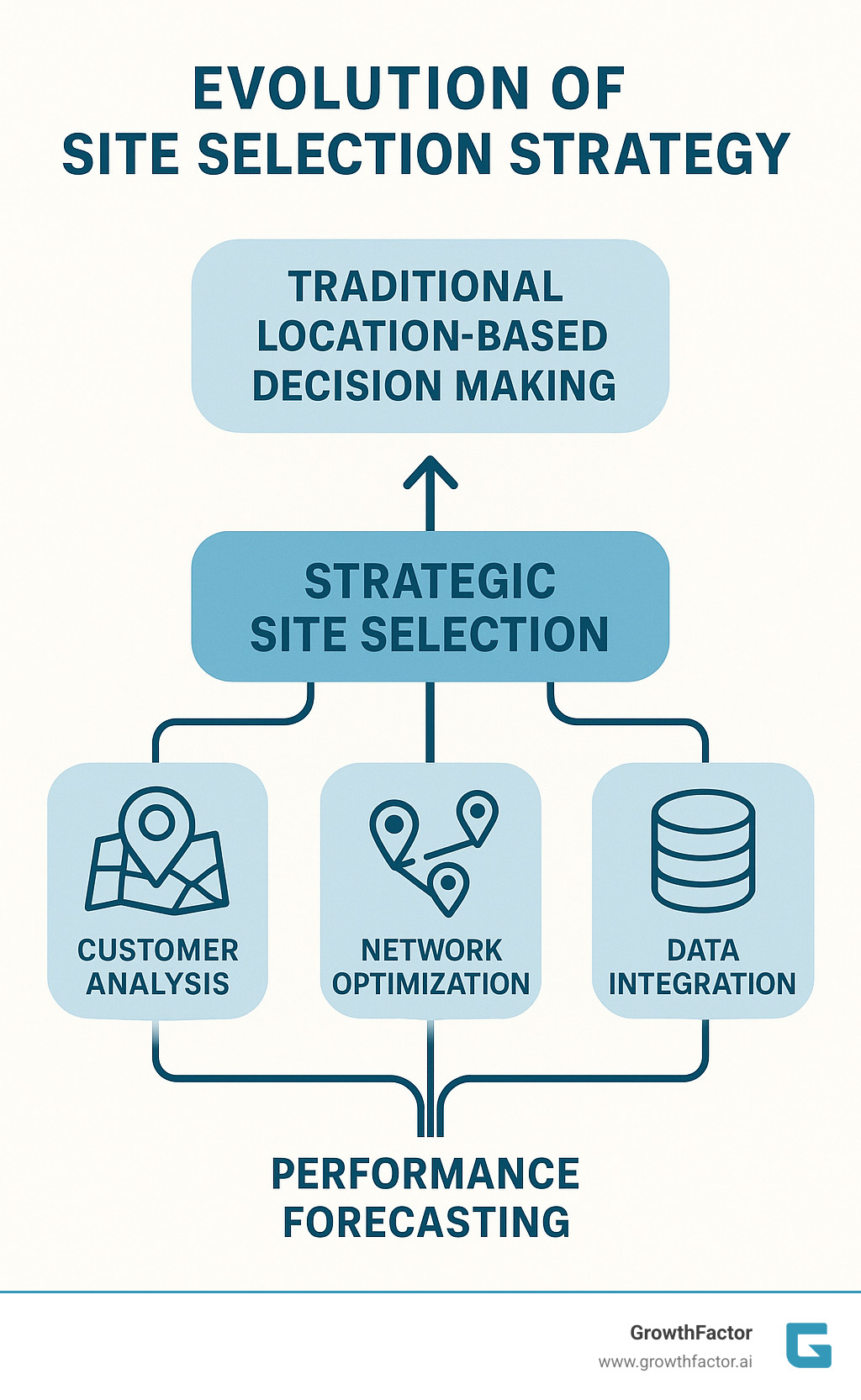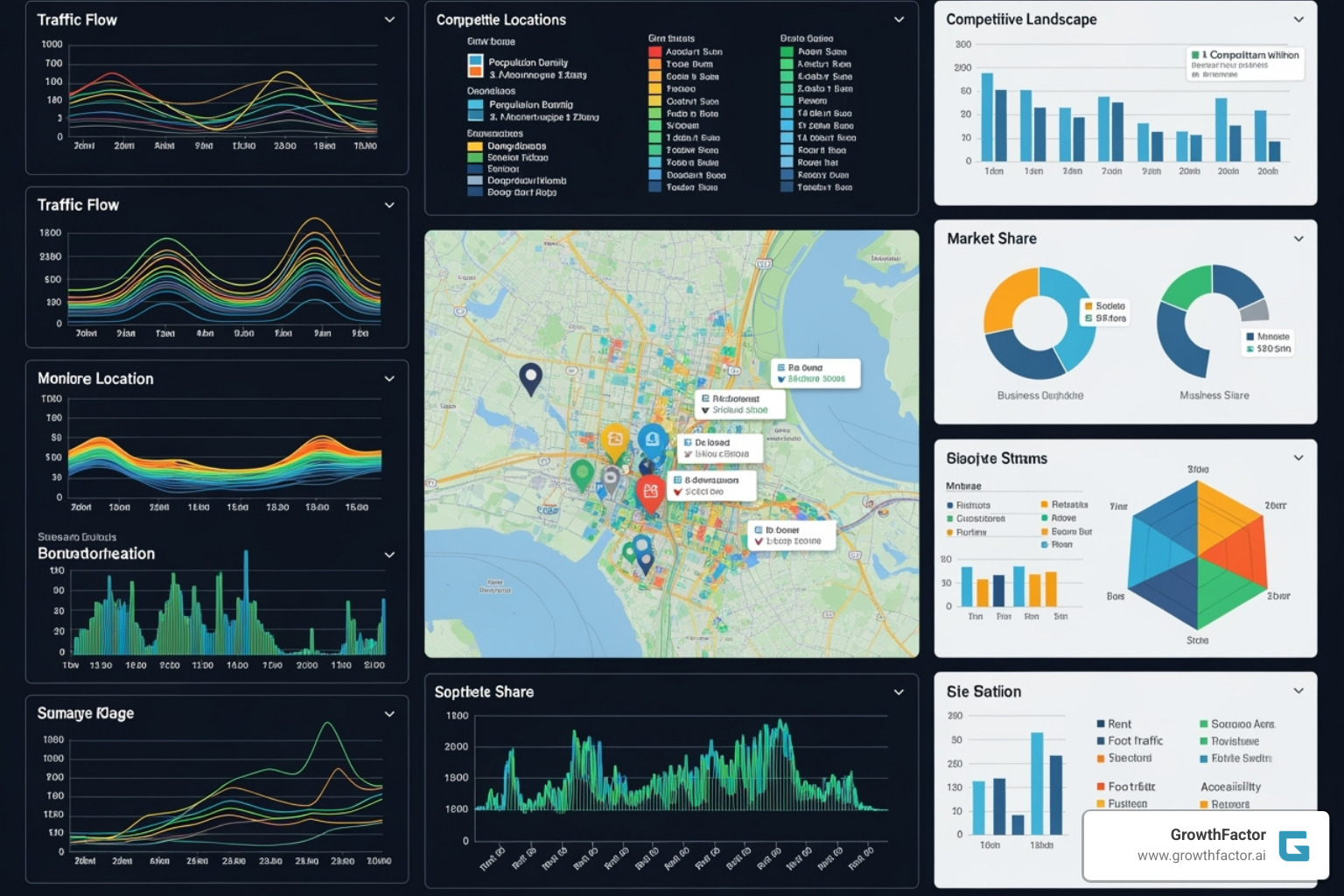Step-by-Step Guide to Site Selection Strategy
Written by: Clyde Christian Anderson
From Tactical Moves to Strategic Vision
A site selection strategy is a comprehensive, data-driven approach to identifying and evaluating potential locations for retail expansion that aligns with long-term business objectives. Unlike tactical site selection, which treats each location as an isolated decision, a strategic approach views your entire network as an interconnected system designed to maximize market coverage and minimize cannibalization.
Key Components of Site Selection Strategy:
- Customer-centric approach: Focus on where your ideal customers live, work, and shop
- Network planning: Consider how new locations impact existing stores
- Data-driven analysis: Use demographics, traffic patterns, and competitive intelligence
- Long-term vision: Align location decisions with 5-10 year growth objectives
- Cross-functional execution: Integrate real estate, operations, finance, and marketing teams
The modern mantra has shifted from "location, location, location" to "customer, customer, customer." This requires sophisticated analysis of demographics, purchasing patterns, and lifestyle preferences to find where your target consumers cluster.
With retail space at a premium and competition intensifying, the stakes for choosing a location are higher than ever. A single decision impacts everything from tax structure and supply chain to labor force and operating success. Today's decision-makers demand data-driven certainty, using advanced analytics to evaluate five times more sites efficiently while maintaining forecast accuracy above 95%.
I'm Clyde Christian Anderson, Founder and CEO of GrowthFactor.ai. After experiencing the frustrations of spreadsheet-based location decisions in my retail and investment banking career, I've helped clients open up $1.6M in cash flow through strategic site selection strategy implementation. My approach combines AI technology with practical retail knowledge to make sophisticated location intelligence accessible to growing retailers.

Phase 1: Laying the Groundwork for Success
A successful site selection strategy requires meticulous groundwork to align decisions with business objectives. This initial phase involves defining your goals, assembling the right team, and establishing your process.

Defining Your Core Objectives
Clearly define your business goals for the new location. Are you pursuing market expansion in a new region like Boston, MA, consolidating operations for efficiency, or establishing a "Center of Expertise" for R&D? Identify your "non-negotiables"—the absolute must-haves for a site—and establish clear, measurable success metrics. Prioritize critical location factors and ensure consensus on these objectives across all stakeholders to prevent an unfocused search.
Assembling Your Cross-Functional Team
A successful site selection strategy requires a multidisciplinary team to avoid inefficiencies. Your core team should include management-level individuals from:
- Real Estate: Manages property identification, evaluation, and negotiation.
- Operations: Assesses logistical feasibility and supply chain impact.
- Human Resources (HR): Analyzes talent supply, cost, and competition. Given today's labor market, HR's role is vital. Insights on labor shortages show that including HR early is a best practice.
- Finance: Conducts financial analyses, evaluates costs, and manages budgets.
- Information Technology (IT): Ensures infrastructure availability and compatibility.
- Legal: Steers zoning, permitting, contracts, and compliance.
- Executive Leadership: Provides strategic direction and secures crucial buy-in.
Engaging outside consultants for specialized expertise can provide a well-rounded, unbiased approach. Throughout this phase, maintaining strict project confidentiality is paramount to protect negotiation leverage.
More info about building site selection teams
Phase 2: The Core Components of a Winning Site Selection Strategy
This phase combines hard data with real-world insights to identify locations that will drive long-term success. It centers on three core activities: understanding your customers, evaluating site characteristics, and analyzing the financials.

Understanding Your Customer and Market Potential
The modern mantra for real estate is "customer, customer, customer." A successful site selection strategy begins with a deep understanding of your best customers.
- Demographics & Psychographics: Go beyond basic data like age and income. Analyze psychographics—lifestyle preferences, values, and purchasing patterns—to create a clear picture of your ideal customer. Relying solely on demographics is a common mistake.
- Spending Power: Ensure the area's disposable income aligns with your price point.
- Trade Area Analysis: Use modern location data to see your actual customer base and foot traffic patterns. This helps assess cannibalization risk from new locations and identify attractive co-tenants.
These elements allow you to confidently estimate an area's commercial potential and project revenue.
Learn more about retail location analysis
Mastering Key Site Selection Factors
Next, evaluate the physical and environmental characteristics of potential sites.
- Accessibility: Customers and employees must be able to reach your site easily via roads and public transport, with adequate parking.
- Visibility: The best locations have excellent visibility from high-traffic areas with easy ingress and egress.
- Zoning Regulations: Investigate local and state guidelines early to understand development potential and operational flexibility.
- Competition Analysis: Map the competitive landscape to find a balance between oversaturation and lack of market demand.
- Co-tenancy: The right neighboring businesses attract similar customers, creating synergistic traffic.
- Labor Market: Assess labor availability, skill levels, and costs. For many businesses, attracting quality employees is the primary site selection criterion.
- Supply Chain Logistics: For distribution and manufacturing, evaluate infrastructure, utility costs, and land availability to ensure smooth operations, as freight costs often drive competitiveness.
Explore store site selection criteria
Evaluating Economic Incentives and Financials
Economic incentives are the icing on the cake, not the cake itself. Use them as tie-breakers, not primary drivers of your decision.
- Integrated Financial Analysis: Conduct comprehensive 10-year cost analyses that account for upfront investments, ongoing operating costs, and net incentives to understand the true cost of doing business.
- Lease vs. Buy Analysis: Determine the most financially advantageous approach for real estate acquisition.
- Tax & Use Analysis: Optimize your financial approach to the property, as the obvious use isn't always the most profitable.
- Incentive Negotiation & Compliance: Negotiate for tax credits, low-cost loans, and utility discounts, but be conservative with projections to avoid clawbacks. Plan for incentive compliance early to capture all available benefits.
Maintaining confidentiality throughout this process is crucial for maximizing leverage with developers and landlords.
Read the SelectUSA Investor Guide on Site Selection
Phase 3: Leveraging Data and Technology for Precision
In today's competitive landscape, technology is essential for a successful site selection strategy. Modern site selection has evolved from gut-feel decisions into a sophisticated science combining artificial intelligence (AI), geographic information systems (GIS), and predictive analytics to uncover previously hidden insights.

The Role of AI in Modern Site Selection
AI is revolutionizing location decisions, making the process more efficient and accurate. Our AI Agent Waldo, for example, enables retail teams to evaluate five times more potential sites with the same level of thoroughness.
- Automated Analysis: AI processes massive datasets in hours, identifying patterns and correlations that analysts might miss by simultaneously analyzing hundreds of variables.
- Predictive Sales Forecasting: Modern AI can forecast revenue for new locations with over 95% accuracy by considering demographics, competition, and more, enabling confident investment decisions.
- Competitive Intelligence: AI maps competitor footprints, analyzes customer overlap, and identifies market gaps.
- Scenario Modeling: Run "what-if" analyses to understand potential risks and opportunities, such as the impact of a new highway or a major employer leaving the area.
This technology allows for decisions based on concrete intelligence. However, be warned: free, accessible online data is often outdated or incorrect, making it a dangerous source for critical business decisions.
Find AI for retail site selection
Building a Data-Driven Site Scoring Model
An effective site scoring model objectively evaluates and ranks potential locations based on your business priorities.
- Criteria Weighting: Assign importance to different factors based on your business model. A coffee shop might prioritize foot traffic, while a distribution center focuses on transportation access.
- Data Integration: Combine reliable data streams, including foot traffic analytics, demographics, and psychographics. Ensure data sources are current and consistent across all evaluated locations.
- Quantitative and Qualitative Inputs: Use hard numbers like population density and traffic counts, but also include qualitative factors like neighborhood character and growth trajectory.
- Scorecard Development: Bring all criteria into a unified framework that scores and ranks each potential site, making comparisons defensible and clear.
Using consistent, high-quality data sources is key to fair comparisons and better location choices. The goal is not to replace human judgment but to improve it with reliable, comprehensive analysis.
See how data-driven site selection works
Tips for sales forecasting in site selection
Phase 4: Execution, Evaluation, and Avoiding Pitfalls
A brilliant site selection strategy requires flawless execution. This final phase transforms planning into success through due diligence, smart network thinking, and continuous improvement.

Assessing Long-Term Potential and Network Impact
Treating each new location as an island is an outdated approach. A strategic approach considers how every site decision impacts your entire network.
- Cannibalization Analysis: Dive deep into trade area overlap to understand how sales might shift between locations. A small amount of cannibalization can be acceptable if it captures market share from competitors.
- Omnichannel Strategy: Consider how a physical store supports online sales, serving as a fulfillment hub and boosting local e-commerce.
- Future Growth Potential: Analyze how demographic shifts, new developments, or changing traffic patterns could impact a location's viability in 10-20 years.
- Network Optimization: Ensure each new location strengthens the overall network by reaching new customers without creating unnecessary overlap.
Develop your retail expansion strategy
Common Pitfalls in Your Site Selection Strategy and How to Avoid Them
These common, preventable mistakes can derail a site selection project.
- Over-relying on Demographics: Demographics are just one piece of the puzzle. Foot traffic and psychographic data can reveal opportunities that demographics alone might miss.
- Ignoring Local Dynamics: Understand local competition, community trends, and political factors. What works in one city may not work in another.
- Poor Due Diligence: Thoroughly check zoning compliance, environmental risks, and soil conditions to avoid costly surprises.
- Breach of Confidentiality: Leaks can torpedo your negotiating power with landlords and economic developers.
- Mismanaging Incentives: Failing to set up proper compliance systems for incentives can lead to significant financial penalties down the road.
Data without context and experience can be misleading. The internet is a source, not a solution.
Understand the basics of what site selection is
Continuous Improvement: Evaluating Performance and Adapting
The work isn't over once the doors open. Continuous evaluation is key to long-term success.
- KPI Tracking: From day one, compare actual performance (sales, foot traffic, labor) against your initial projections to validate your process.
- Post-Opening Analysis: Create a feedback loop. When a location succeeds or fails, analyze why to inform future decisions.
- Monitor Evolving Trade Areas: Stay on top of new developments, demographic shifts, and competitor movements that can alter a location's performance.
- Adapt Your Strategy: The retail landscape changes rapidly. Agility in your location strategy ensures your portfolio remains optimized for long-term growth.
Companies that accept continuous evaluation build retail empires that last.
Learn how to choose a retail location
Frequently Asked Questions about Site Selection Strategy
What is the difference between strategic and tactical site selection?
Tactical site selection is reactive, treating each new location as an isolated project to meet a short-term goal. Strategic site selection is a proactive, holistic process that aligns every location decision with long-term business objectives. It views the entire network of locations as a single, interconnected asset, ensuring each new site strengthens the whole enterprise.
How has technology changed the site selection process?
Technology has transformed site selection from a gut-feel exercise into a data-driven science. Tools like GIS, AI, and advanced analytics allow for the rapid analysis of massive datasets, including customer demographics, purchasing habits, and traffic patterns. This enables highly accurate predictive sales forecasting and a much deeper understanding of market dynamics. As a result, the process is faster, smarter, and more accurate, uncovering opportunities that were previously hidden. Learn more about AI-powered retail analytics.
What is the most important factor in a site selection strategy?
While factors like accessibility, visibility, and labor availability are critical, the modern consensus is that the customer is the most important factor. The mantra has shifted from "location, location, location" to "customer, customer, customer." A location is only as good as its ability to attract and serve your specific target customer base. Therefore, a deep, data-driven understanding of your customer—who they are, where they are, and how they behave—is the foundational element of any winning site selection strategy.
Conclusion: Building Your Future, One Location at a Time
A brilliant site selection strategy is more than picking a spot on a map; it's laying the groundwork for your business's future. This means shifting from isolated decisions to a holistic, customer-centric, and data-driven approach. A strategic mindset allows you to see how each new site impacts your entire network and contributes to your long-term vision.
By leveraging advanced analytics and powerful AI, like our AI Agent Waldo, you can eliminate guesswork. This commitment ensures every new location, whether across the United States or in a specific market like Boston, MA, is positioned for success. Each site will contribute to your growth goals and maximize your return on investment.
At GrowthFactor, we empower real estate and expansion teams with the tools and insights needed to make these pivotal decisions with confidence and precision.
Citations
The human algorithm
Request Your demo
Schedule meeting
Or submit your information below and we'll be in touch to schedule.



